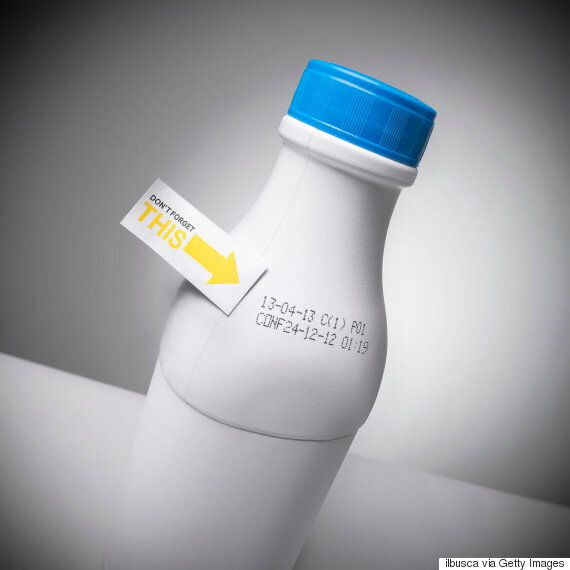Spoiled milk is one of the worst surprises anyone can encounter. The initial sourness is bad enough. Yet for those who dare to take in more than a sip, the accompanying solid pieces can revolt almost any palate.
As one might expect, the suspects behind the change from silky and sweet to thick and putrid are microbial in nature. A variety of bacterial species simply love the nutritious value of milk and work quickly to take in those sugars, fats and proteins for their benefit. But this isn't how spoiling happens. It's after they eat that the real trouble begins.

Like humans, bacteria form waste products. However, they do not have the equivalent of sewer systems; they simply throw the unwanted remains into the environment. As their numbers grow, the amount of unappetizing molecules such as acids, peptides and fatty acids also increase. Soon, the once-tasty white liquid becomes an off-colour, smelly slurry that no one wants to drink.
Over the last century, we've learned how to keep the numbers of bacteria down through a process known as pasteurization. It's a simple method in which the milk is brought to a temperature high enough to kill off the majority of bacteria and then cooled to avoid any damage to the taste. Although this does not preserve the milk forever, one can get away with keeping it in the fridge for a few days to a week without worry. Go beyond that time, however, and you may be risking your taste buds.
In addition to normal pasteurization, several other techniques have been used to improve the shelf life of milk products. Methods with names such as extended shelf-life, batch holding, and ultra-high temperature, or UHT can ensure milk can be stored without the need for a fridge. Then there is sterilization, which as the name implies, ensures there is nothing living.
Apart from sterilization, all treated milks eventually will go bad. Yet little research has been conducted to best understand how long milk will remain drinkable. This has left us relying solely on the best before date on the package to determine if we are risking a nasty mouthful. Sadly, many of us find the date may not be as accurate as we would like.

For an international team of researchers, this gap needed to be filled. They teamed up to examine all the information on milk spoilage over the years in the hopes of better identifying the triggers for spoilage. Their efforts proved worthwhile as they found one particular type of bacterial product may be the linchpin to knowing when milk will go from delicious to disgusting.
The first step was to look at raw milk to identify the potential bacterial culprits involved in spoilage. Considering milk that comes straight out of the udder may have tens of millions of bacteria per millilitre, there was much to explore. Most of the microbes were related to the cow's own microbial population, but some species were considered to be troublesome.
The next step was to look at the equipment used to collect and transport milk. In this case, the potential for spoilage dramatically increased as several potential suspects were found in various milking machines and storage equipment. Many were persistent thanks to the formation of bacterial cities known as biofilms. If they could somehow get into the milk supply, the chances for trouble most definitely increased.
The next step was to examine the potential for growth during storage, which normally occurs in refrigerator-like temperatures. Most of the microbes from the animals did not do so well but those machine contaminants seemed to be able to stick around and even grow. This suggested ingestion of raw milk at any stage other than straight out of the udder could lead to a rather sour memory.
In the meantime, the best option to avoid a mouthful of mire would be to keep an eye on that best before date.
Finally, the team examined what happened to these bacteria after pasteurization. Although the bacteria were for the most part killed -- as expected -- there was a surprise in store. Some of the molecules used by these species to survive, known as heat-resistant degrading enzymes, appeared to withstand the heating process. This meant the chances for infection were greatly reduced, yet the freshness of milk was in jeopardy.
The trouble with having an enzyme is that it continues to do its job even if there is no living organism around to benefit from the activity. As the team learned, these molecules continue to break down the components of milk into the very same distasteful waste products. Depending on how many of these enzymes are present in the liquid, the batch could become spoiled even without the presence of microbes.
For the authors, this revelation was somewhat depressing. Despite all the knowledge we have about these types of heat-resistant enzymes, there are no control options available. New industrial processes would have to be incorporated at a significant cost.
The only real option would be to perform a microbial test prior to pasteurization. If any of the bacteria known to make these enzymes are present, then the milk would have to be given a shorter shelf life. But this would entail other problems. After all, few people would look for the nearest expiry date when purchasing milk.
The milk industry no doubt will figure out how to deal with the problem of heat-resistant enzymes. In the meantime, the best option to avoid a mouthful of mire would be to keep an eye on that best before date. If the time is getting close or passed, you may want to be a little more careful when you decide to drink.
Follow HuffPost Canada Blogs on Facebook
Also on HuffPost:
